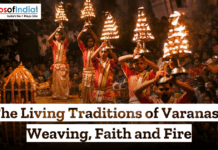The tradition of wearing a turban by Sikhs is gloriously emblematised by the Turban hanging around from under the patka to form a glorious hanging. The Sikhs would regularly say that it is not just an ornament to him but the fabric out of which his spiritual life, honour, community, and living will be shaped. This symbol of faith is historically deep-rooted and is found among new sects of Sikhs. Such symbols have been kept alive by the pride in one’s culture besides a show of resistance from and to dominating trends, which, for example, gets illustrated in the following piece, which involves introspections about its multiple representations within the complex Punjabi society.
Turbans of Sikhs of different orders and communities in Punjab
The Turban is among the key spiritual and social symbols of the Sikh orders regarding the personality of the Punjabi members. It stands as a mark of devotion to the faith and an emblem of the tenets of bravery, equality, and service of the believers. Different communities may express their idiosyncrasies of belief and thus allegiance to a particular sect through various styles and colours they wear. In the end, whether the bright Turbanl or the Turban has come to mean something more than anything for Punjabi Sikhs, it acts as a common thread that gives meaning to their identity and culture.
Significance to Sikhs
Sikhism places significant importance on the story of Turban. It symbolises respect, allegiance, and Turbaness of Guru Nanak’s message. To Sikhs, wearing a turban is an allegiant act representing their religion and how their Sikh tradition regulates their wearing of it.
It also symbolises equality and humility. This last section in the music video is mainly linked to the daily tying of a turban, representing one’s validation of their Sarbast Das Bhalla and acting according to the will of God and higher justice. It goes beyond a mere piece of clothing that one might print around with; it is a central feature of the Sikh code of ethics.
Styles of a Turban
For instance, Punjab has innumerable turbans in different patterns and types, reflecting cultural symbolism and individual preference. Many turbans are traditional, like the larger Patiala Style Turban and Dualla, which is longer and wraps the Turban multiple times around the head.
Furthermore, colours and patterns have a lot to say. Bright colours indicate joy and happiness, whereas dark blue or black represent grieving or loss. Besides, sects invariably impose individual-specific styles very often. For example, some Sikhs wear the Kesik since they abide by their calendar based on their beliefs.
Problems Facing of Sikhs Tying The Turban
Individuals following the Sikh religion generally encounter problems when going into public places and working while wearing a Turban. Prejudice more likely begins with false characterisations about the subject, thereby opening the person to wrongful administration, as in the case of employment.
Certain professions may restrict headgear, leading to a crossroads for Sikhs who wish to pursue their faith while building a career. Societal pressures may be too powerful, and individuals who try to manage traditional and modern beliefs could feel lost.
Conflicts of Sikhism with Secular Law
Water can be an issue for turban-wearing Sikhs with civil laws, especially in areas where the political problem of secular law goes head to head with cultural practices. Disagreements on dress codes at schools and workplaces where turbans may not be deemed understandable or against regulations are some of the issues.
It will be scrutinised whether religious freedom is not out of harmony with uniformity. Such circumstances eulogise the continuing controversy regarding the affirmation of Sikh identity within the mainstream social system and stress the need for the preservation of various aspects of culture, such as men’s Turbans, in daily life.
In-depth Look into the Sikh Orders
The Sikh religion consists of different sects, each with a unique way of practising religion, which involves the Turban, among other things. For instance, the Nanak Panthis style consists of the Yadav dynasty, another about 5,000-year-old style. Some Indian states had similar turban practices among rulers from the same period at the time of Sikhism.
Indeed, they are grounded firmly in Sikhism. Different colours of turbans have their special spiritual meanings associated with the Sikhs. Each colour has a different Rasa, feeling, or spiritual aspiration: Daru, Shaan, or Rukh.
Moreover, they facilitate expressing self-identity and community affiliation. After washing your clothes, refrain from people’s things and all other things of Sikhs that are blue, Panjabi, and air ballet. The use of similar lines at religious festivities and celebrations of various cultural events in the region ultimately contributes to the vibrant atmosphere in the area.
Benefits and Reasons for Wearing a Turban
Though wearing a turban expresses culture, it serves many more purposes. It protects the wearer from harsh sunlight and inclement weather, underlining its functional reason for daily wear in the rapidly changing Punjab climate.
Besides, the Turban pulls a string of social kinship and faith, giving a chance to self-expression about belonging in the community. This membership is shared by persons who regard both of them with respect and admiration, the maturity of which is perceived in another set of meanings. This appears in how one wears the Turban and tempers one’s perceptions and impressions while being faithful to one’s beliefs and community norms.
Material and Type of Turban
Turban symbolises Sikh identity and respect. However, several types and materials are available. A typical turban is made of cotton or polyester blends for strength and comfort. These fabrics wash easily and are very light, allowing an excellent air supply for outdoor use.
So, the silk turban represents noble elegance and is specified as the official evening event and during the most prestigious ceremonies. The choice of the material is usually based on individual and cultural contexts.
Certain regions may similarly influence the styles, preferring a particular style, such as urban-specific practices or religious beliefs. Every Turban exemplifies the story of culture, loyalty, and honour, from complex schemes to rudimentary roles. Diversity in these realms has added to the aesthetic amplitude of Punjab and further spread the spiritual value recognised by the Turban in Sikhism.




